Go Excelize API源码解析GetSheetFormatPr使用示例
来源:脚本之家
时间:2022-12-26 21:34:11 449浏览 收藏
本篇文章主要是结合我之前面试的各种经历和实战开发中遇到的问题解决经验整理的,希望这篇《Go Excelize API源码解析GetSheetFormatPr使用示例》对你有很大帮助!欢迎收藏,分享给更多的需要的朋友学习~
一、Go-Excelize简介
Excelize 是 Go 语言编写的用于操作 Office Excel 文档基础库,基于 ECMA-376,ISO/IEC 29500 国际标准。
可以使用它来读取、写入由 Microsoft Excel™ 2007 及以上版本创建的电子表格文档。
支持 XLAM / XLSM / XLSX / XLTM / XLTX 等多种文档格式,高度兼容带有样式、图片(表)、透视表、切片器等复杂组件的文档,并提供流式读写 API,用于处理包含大规模数据的工作簿。
可应用于各类报表平台、云计算、边缘计算等系统。
使用本类库要求使用的 Go 语言为 1.15 或更高版本。
二、GetSheetFormatPr
func (f *File) GetSheetFormatPr(sheet string, opts ...SheetFormatPrOptionsPtr) error
根据给定的工作表名称获取格式属性。
| 可选格式参数 | 数据类型 |
|---|---|
| BaseColWidth | uint8 |
| DefaultColWidth | float64 |
| DefaultRowHeight | float64 |
| CustomHeight | bool |
| ZeroHeight | bool |
| ThickTop | bool |
| ThickBottom | bool |
使用示例:
f := excelize.NewFile()
const sheet = "Sheet1"
var (
baseColWidth excelize.BaseColWidth
defaultColWidth excelize.DefaultColWidth
defaultRowHeight excelize.DefaultRowHeight
customHeight excelize.CustomHeight
zeroHeight excelize.ZeroHeight
thickTop excelize.ThickTop
thickBottom excelize.ThickBottom
)
if err := f.GetSheetFormatPr(sheet,
&baseColWidth,
&defaultColWidth,
&defaultRowHeight,
&customHeight,
&zeroHeight,
&thickTop,
&thickBottom,
); err != nil {
fmt.Println(err)
}
fmt.Println("Defaults:")
fmt.Println("- baseColWidth:", baseColWidth)
fmt.Println("- defaultColWidth:", defaultColWidth)
fmt.Println("- defaultRowHeight:", defaultRowHeight)
fmt.Println("- customHeight:", customHeight)
fmt.Println("- zeroHeight:", zeroHeight)
fmt.Println("- thickTop:", thickTop)
fmt.Println("- thickBottom:", thickBottom)
输出结果:
Defaults:
- baseColWidth: 0
- defaultColWidth: 0
- defaultRowHeight: 15
- customHeight: false
- zeroHeight: false
- thickTop: false
- thickBottom: false
废话少说,上代码:
func (f *File) GetSheetFormatPr(sheet string, opts ...SheetFormatPrOptionsPtr) error {
s, err := f.workSheetReader(sheet)
if err != nil {
return err
}
fp := s.SheetFormatPr
for _, opt := range opts {
opt.getSheetFormatPr(fp)
}
return err
}
代码很简单,先读取工作表,然后获取工作表的格式属性,然后遍历不定长参数opts,对fp的每个opt进行读取。
SheetFormatPrOptionsPtr是一个interface。
type SheetFormatPrOptionsPtr interface {
SheetFormatPrOptions
getSheetFormatPr(formatPr *xlsxSheetFormatPr)
}
该interface 内有两个函数。
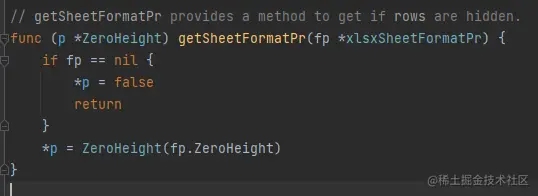
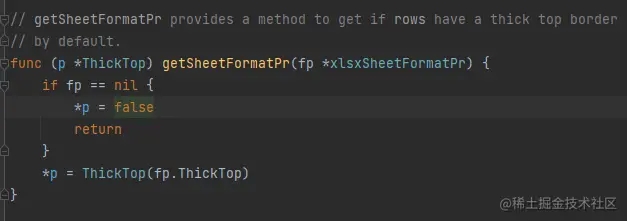
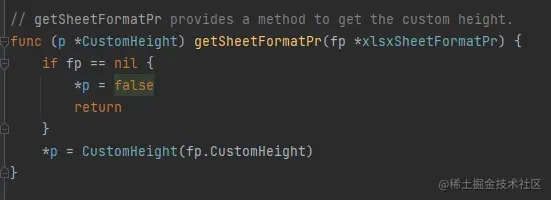

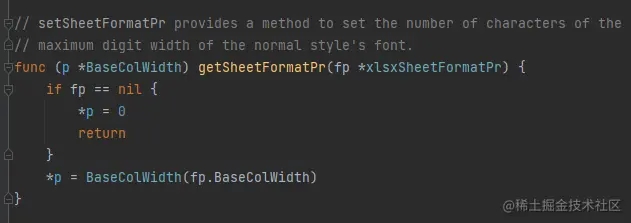
我们可以发现,他们都大同小异,第一步的if语句是判断格式属性是否存在,如果不存在就赋一个默认值。 然后取格式属性指针fp的格式属性,前面是类型转换:
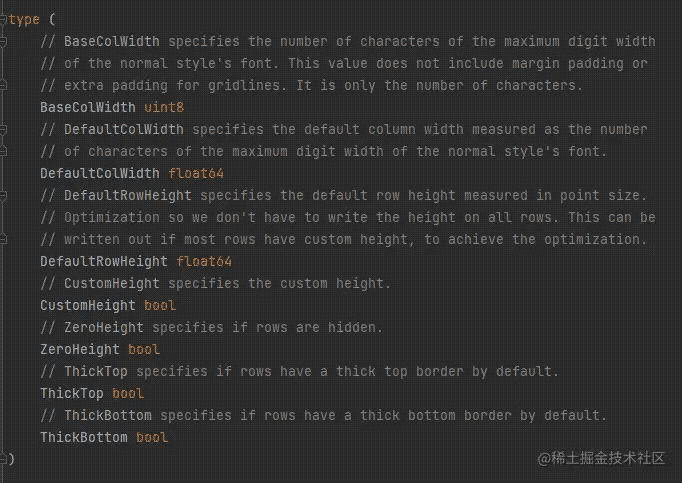
type xlsxSheetFormatPr struct {
XMLName xml.Name `xml:"sheetFormatPr"`
BaseColWidth uint8 `xml:"baseColWidth,attr,omitempty"`
DefaultColWidth float64 `xml:"defaultColWidth,attr,omitempty"`
DefaultRowHeight float64 `xml:"defaultRowHeight,attr"`
CustomHeight bool `xml:"customHeight,attr,omitempty"`
ZeroHeight bool `xml:"zeroHeight,attr,omitempty"`
ThickTop bool `xml:"thickTop,attr,omitempty"`
ThickBottom bool `xml:"thickBottom,attr,omitempty"`
OutlineLevelRow uint8 `xml:"outlineLevelRow,attr,omitempty"`
OutlineLevelCol uint8 `xml:"outlineLevelCol,attr,omitempty"`
}
下面介绍一下各个参数的作用:
- BaseColWidth:指定普通样式字体的最大数字宽度的字符数。此值不包括边距填充或网格线的额外填充。它只是字符数。
- DefaultColWidth 指定默认列宽,其度量值为普通样式字体的最大数字宽度的字符数。
- DefaultRowHeight 指定以磅值度量的默认行高,我们不必在所有行上写入高度。如果大多数行具有自定义高度,则可以将其写出,以实现优化。
- CustomHeight 指定自定义高度。
- ZeroHeight 指定是否隐藏行。
- ThickTop 指定默认情况下行是否具有粗上边框。
- ThickBottom 指定默认情况下行是否具有粗下边框。
本篇关于《Go Excelize API源码解析GetSheetFormatPr使用示例》的介绍就到此结束啦,但是学无止境,想要了解学习更多关于Golang的相关知识,请关注golang学习网公众号!
-
116 收藏
-
279 收藏
-
270 收藏
-
189 收藏
-
485 收藏
-
259 收藏
-
460 收藏
-
394 收藏
-
109 收藏
-
428 收藏
-
476 收藏
-
148 收藏
-
252 收藏
-
106 收藏
-
290 收藏
-
206 收藏
-
244 收藏
-

- 前端进阶之JavaScript设计模式
- 设计模式是开发人员在软件开发过程中面临一般问题时的解决方案,代表了最佳的实践。本课程的主打内容包括JS常见设计模式以及具体应用场景,打造一站式知识长龙服务,适合有JS基础的同学学习。
- 立即学习 543次学习
-

- GO语言核心编程课程
- 本课程采用真实案例,全面具体可落地,从理论到实践,一步一步将GO核心编程技术、编程思想、底层实现融会贯通,使学习者贴近时代脉搏,做IT互联网时代的弄潮儿。
- 立即学习 516次学习
-

- 简单聊聊mysql8与网络通信
- 如有问题加微信:Le-studyg;在课程中,我们将首先介绍MySQL8的新特性,包括性能优化、安全增强、新数据类型等,帮助学生快速熟悉MySQL8的最新功能。接着,我们将深入解析MySQL的网络通信机制,包括协议、连接管理、数据传输等,让
- 立即学习 500次学习
-

- JavaScript正则表达式基础与实战
- 在任何一门编程语言中,正则表达式,都是一项重要的知识,它提供了高效的字符串匹配与捕获机制,可以极大的简化程序设计。
- 立即学习 487次学习
-

- 从零制作响应式网站—Grid布局
- 本系列教程将展示从零制作一个假想的网络科技公司官网,分为导航,轮播,关于我们,成功案例,服务流程,团队介绍,数据部分,公司动态,底部信息等内容区块。网站整体采用CSSGrid布局,支持响应式,有流畅过渡和展现动画。
- 立即学习 485次学习
